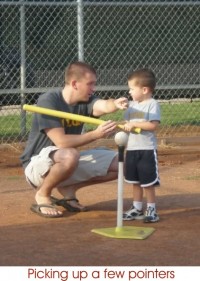
My New Favorite Sport is a BLAST!
It’s Opening Day for the Little Bitty Boys of Summer
I’ve never really been a huge fan of baseball. There. I said it.
I know I risk total alienation by admitting that fact, but the truth is I find the sport to be just a tad boring. No offense to Abner Doubleday personally, but I mean come on. One guy at a time trying to hit one ball at a time? Wake me when it’s over. Now maybe if six guys took the plate simultaneously, blindfolded, and everybody in the field starting throwing a battery of balls at them all at once, that would be exciting. As it is though, I just can’t get into it.
Or at least I couldn’t up until now. Remarkable as it may seem, I have a brand new passion for a sport that has its very roots in baseball. It’s called Blastball.
Naturally when I describe the fundamentals of the game, you’ll probably think I’ve lost my ever-lovin’ mind, but trust me, once you understand Blastball the way I do, I promise you’re going to rise up and call me blessed for introducing you to it. So gather up your clipboards and get ready to take some serious notes. If we finish early, we may even have time for a game film at the end.
 Let’s get started. As I said, Blastball has its roots in baseball, or more specifically in T-Ball, a sport that was developed as a means of introducing five-year-olds to the basics – batting, the layout of the bases, that sort of thing. Well, leave it to a bunch of dads to figure that if age five is good, age three is better. Hence: Blastball, probably the only official organized sport where the players are barely out of training pants.
Let’s get started. As I said, Blastball has its roots in baseball, or more specifically in T-Ball, a sport that was developed as a means of introducing five-year-olds to the basics – batting, the layout of the bases, that sort of thing. Well, leave it to a bunch of dads to figure that if age five is good, age three is better. Hence: Blastball, probably the only official organized sport where the players are barely out of training pants.
It won’t take long to explain how it works. After all, there’s only one base (that honks when you step on it) and no scoring. A little player approaches the plate and after being physically picked up and turned around so that he’s actually facing the right way, he begins taking swings at the ball on the "T”. If the ball goes more than ten feet, it’s a "hit”. Then he just stands there watching the other team converge en masse on the ball, totally forgetting that he’s supposed to take off running for the base. (In one case I saw a batter literally head for the ball himself, to keep the other team from coming up with it!) After a bit of prodding from the dads, he eventually starts running and when he reaches the base, he jumps mightily on it with both feet, producing the desired "honk” that signifies his accomplishment. Meanwhile, after a bit of a free-for-all, somebody on the team in the field manages to end up with the ball, at which point that player yells "Blast” and hurls the ball back to the dad at home plate.
Judging by the way I described it, you’d think these little guys were really into it, but that’s not always the case. Remember, we’re dealing with three-year-olds here. For them the loose dirt on the diamond often holds more fascination than the actual game. In fact it’s not unusual to see half the team squatted down playing in the sand, or trying to coax a doodle bug onto their stubby little fingers.
But take it from me, any enthusiasm lacking from the players themselves is more than made up for by the spectators in the bleachers. You’ve never heard such whooping and hollering (is it just me, or do grandparents really yell louder than the parents?) and whenever the batter is lucky enough to make contact with the ball, the whole grandstand goes wild.
It’s a pretty fast game – fifty minutes from start to finish – and when it’s over, it’s over. Nobody wins. Nobody cares. The kids do the traditional "good game” hand slap lineup with the other team, and then they make a beeline for their favorite part of the whole activity – juice boxes and Teddy Grahams.
So there you have it – the glories of Blastball. The good news is we’ve still got time for that game film, which I’ve posted below. Of course once you watch it you’ll probably have a good idea why I’ve suddenly become such a huge fan of the sport – I’m absolutely crazy about the little guy in the orange hat. He’s on his way to the majors, I just know it, and you can bet that Grammy is going to be there, cheering him every step of the way!
- Search for Grandchildren articles similar to "My New Favorite Sport is a BLAST!.
- Search all articles similar to "My New Favorite Sport is a BLAST!".
- List all Grandchildren articles.
Terms & Conditions | Contact | Login | This website designed by Shawn Olson